2014 |
||||
| 41. |  | Burkhardt, Dirk; Nazemi, Kawa; Kohlhammer, Jörn Visual Process Support to Assist Users in Policy Making Book Chapter In: Sonntagbauer, Peter; Nazemi, Kawa; Sonntagbauer, Susanne; Prister, Giorgio; Burkhardt, Dirk (Ed.): Handbook of Research on Advanced ICT Integration for Governance and Policy Modeling, Chapter 9, pp. 129–148, IGI Global, Hershey, PA, USA, 2014, ISBN: 9781466662360. Abstract | Links | BibTeX | Dimensions | PlumX | Tags: Adaptation, Adaptive Visualization, Information and Communication Technologies, Policy, Policy Modeling, Process, SemaVis @inbook{Burkhardt2014f,The policy making process requires the involvement of various stakeholders, who bring in very heterogeneous experiences and skills concerning the policymaking domain, as well as experiences of ICT solutions. Current solutions are primarily designed to provide “one-solution-fits-all” answers, which in most cases fail the needs of all stakeholders. In this chapter, the authors introduce a new approach to assist users based on their tasks. Therefore, the system observes the interaction of the user and recognizes the current phase of the policymaking process and the profile of the user to assist him more sufficiently in solving his task. For this purpose, the system automatically enables or disables supporting features such as visualization, tools, and supporting techniques. | ||
| 40. |  | Nazemi, Kawa; Steiger, Martin; Burkhardt, Dirk; Kohlhammer, Jörn Information Visualization and Policy Modeling Book Chapter In: Sonntagbauer, Peter; Nazemi, Kawa; Sonntagbauer, Susanne; Prister, Giorgio; Burkhardt, Dirk (Ed.): Handbook of Research on Advanced ICT Integration for Governance and Policy Modeling, Chapter 11, pp. 175–215, IGI Global, Hershey, PA, USA, 2014, ISBN: 9781466662360. Abstract | Links | BibTeX | Dimensions | PlumX | Tags: Adaptation, Adaptive Visualization, Information Visualization, Semantics, Semantics Visualization, SemaVis, Visual Analytics @inbook{Nazemi2014c,Policy design requires the investigation of various data in several design steps for making the right decisions, validating, or monitoring the political environment. The increasing amount of data is challenging for the stakeholders in this domain. One promising way to access the “big data” is by abstracted visual patterns and pictures, as proposed by information visualization. This chapter introduces the main idea of information visualization in policy modeling. First abstracted steps of policy design are introduced that enable the identification of information visualization in the entire policy life-cycle. Thereafter, the foundations of information visualization are introduced based on an established reference model. The authors aim to amplify the incorporation of information visualization in the entire policy design process. Therefore, the aspects of data and human interaction are introduced, too. The foundation leads to description of a conceptual design for social data visualization, and the aspect of semantics plays an important role. | ||
| 39. |  | Sonntagbauer, Susanne; Sonntagbauer, Peter; Nazemi, Kawa; Burkhardt, Dirk The FUPOL Policy Lifecycle Book Chapter In: Sonntagbauer, Peter; Nazemi, Kawa; Sonntagbauer, Susanne; Prister, Giorgio; Burkhardt, Dirk (Ed.): Handbook of Research on Advanced ICT Integration for Governance and Policy Modeling, Chapter 5, pp. 61–87, IGI Global, Hershey, PA, USA, 2014, ISBN: 9781466662360. Abstract | Links | BibTeX | Dimensions | PlumX | Tags: e-Government, e-Participation, FUPOL, Policy Design, Policy Lifecycle, Policy Modeling @inbook{Sonntagbauer2014b,The purpose of this chapter is to outline an advanced policy lifecycle, the FUPOL model with its ability to link technical features in the area of policy modeling. The FUPOL Policy Lifecycle is based on 6 stages, which are further divided into 8 main tasks. These main tasks are split up into 19 subtasks to provide a very detailed policy lifecycle structure. The detailed breakdown allows one to link each task to various technical features, such as opinion maps, policy indicator dashboard, knowledge database, and simulation and visualization tools. The chapter further argues that the methodology applied is future proof and has the potential of accommodating new technologies in the future. | ||
| 38. |  | Burkhardt, Dirk; Nazemi, Kawa; Kohlhammer, Jörn Policy Modeling Methodologies Book Chapter In: Sonntagbauer, Peter; Nazemi, Kawa; Sonntagbauer, Susanne; Prister, Giorgio; Burkhardt, Dirk (Ed.): Handbook of Research on Advanced ICT Integration for Governance and Policy Modeling, Chapter 4, pp. 48–60, IGI Global, Hershey, PA, USA, 2014, ISBN: 9781466662360. Abstract | Links | BibTeX | Dimensions | PlumX | Tags: e-Government, e-Participation, Information and Communication Technologies, Open Data, Policy, Policy Modeling, Process @inbook{Burkhardt2014e,The process to develop sustainable public policies is done by public authorities ensuring the involvement of all stakeholders. ICT is rarely included in most of the today's applied policymaking processes. Other process definitions with a focus on ICT inclusion in policy modeling still exist, but they are not well defined. This chapter gives an overview of the existing policy modeling process types and explains their major foci and how they consider ICT and the practical process in public authorities. Afterwards, based on these descriptions, the general requirements on a new ICT-oriented policy modeling process that allows the inclusion of ICT into a valid and useful process for public authorities is given. | ||
| 37. |  | Burkhardt, Dirk; Nazemi, Kawa; Zilke, Jan Ruben; Kohlhammer, Jörn; Kuijper, Arjan Fundamental Aspects for E-Government Book Chapter In: Sonntagbauer, Peter; Nazemi, Kawa; Sonntagbauer, Susanne; Prister, Giorgio; Burkhardt, Dirk (Ed.): Handbook of Research on Advanced ICT Integration for Governance and Policy Modeling, Chapter 1, pp. 1–18, IGI Global, Hershey, PA, USA, 2014, ISBN: 9781466662360. Abstract | Links | BibTeX | Dimensions | PlumX | Tags: e-Government, e-Participation, Information and Communication Technologies, Open Data, Policy, Policy Modeling @inbook{Burkhardt2014d,The upcoming initiatives using ICT in the government process should strengthen the benefit of e-government in most countries. Since e-government among other e-related terms is a widely (interpreted) term, it is sometimes challenging to understand the objective and goals of an initiative. Therefore, in this chapter, the authors introduce and explain most e-government related terms. Even more, they outline some interesting initiatives and implementations to explain the benefits of using ICT in the government domain. Concrete activities are aligned to the terms to explain their practical use in a better way. The authors conclude with several challenges that arise when thinking of the implementation of e-government services. Overall, this chapter should give a good overall view of e-government and the related issues. | ||
| 36. |  | Sonntagbauer, Peter; Nazemi, Kawa; Sonntagbauer, Susanne; Prister, Giorgio; Burkhardt, Dirk (Ed.) Handbook of Research on Advanced ICT Integration for Governance and Policy Modeling Book IGI Global, Hershey, PA, USA, 2014, ISBN: 9781466662360. Abstract | Links | BibTeX | Dimensions | PlumX | Tags: Citizen Engagement, Civil Service, Decision Making, e-Government, e-Participation, International Relations, Modeling in E-Governance, Policy Development, Policy Lifecycle Analysis, Simulation in E-Governance @book{Sonntagbauer2014,As governments and policy makers take advantage of information and communication technologies, leaders must understand how to navigate the ever-shifting landscape of modern technologies in order to be most effective in enacting change and leading their constituents. The Handbook of Research on Advanced ICT Integration for Governance and Policy Modeling builds on the available literature, research, and recent advances in e-governance to explore advanced methods and applications of digital tools in government. This collection of the latest research in the field presents an essential reference for academics, researchers, and advanced-level students, as well as government leaders, policy makers, and experts in international relations. The many academic areas covered in this publication include, but are not limited to: - Citizen Engagement - Civil Service - Decision-Making Strategies - E-Government - E-Participation Modeling - International Relations - Policy Development - Policy Lifecycle Analysis - Simulation and Modeling in E-Governance | ||
| 35. | 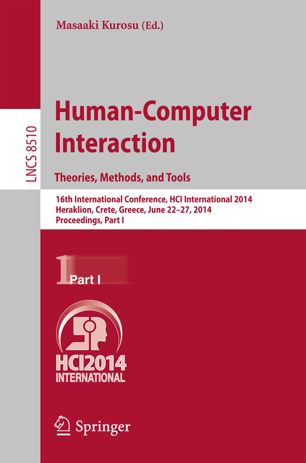 | Burkhardt, Dirk; Nazemi, Kawa; Encarnacao, Jose Daniel; Retz, Wilhelm; Kohlhammer, Jörn Visualization Adaptation Based on Environmental Influencing Factors Proceedings Article In: Kurosu, Masaaki (Ed.): Human-Computer Interaction. Theories, Methods, and Tools. HCI 2014, pp. 411–422, Springer International Publishing, Switzerland, 2014, ISBN: 978-3-319-07233-3. Abstract | Links | BibTeX | Dimensions | PlumX | Tags: Adaptive Visualization, Information Visualization, Sensor Fusion, User Experience, User-Centered Interaction @inproceedings{Burkhardt2014,Working effectively with computer-based devices is challenging, especially under mobile conditions, due to the various environmental influences. In this paper a visualization adaptation approach is described, to support the user under discriminatory environmental conditions. For this purpose, a context model for environmental influencing factors is being defined. Based on this context model, an approach to adapt visualizations in regards of certain environmental influences is being evolved, such as the light intensity, air quality, or heavy vibrations. | ||
2013 |
||||
| 34. | 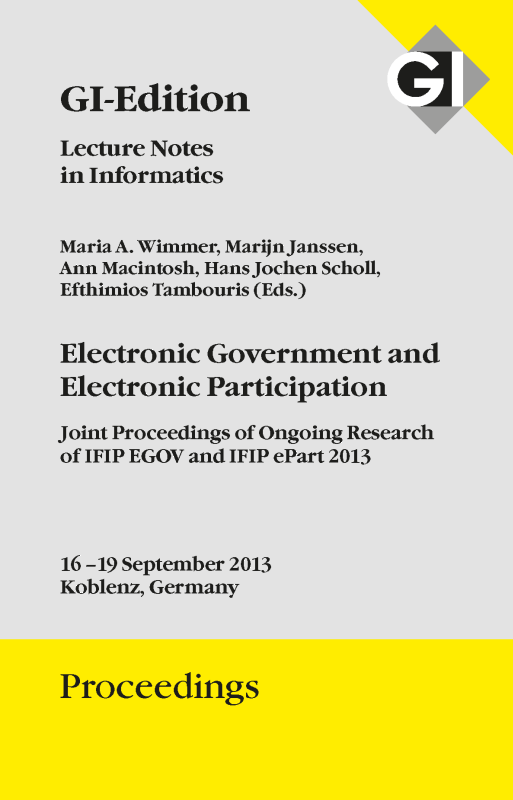 | Burkhardt, Dirk; Nazemi, Kawa; Sonntagbauer, Peter; Sonntagbauer, Susanne; Kohlhammer, Jörn Interactive Visualizations in the Process of Policy Modelling Proceedings Article In: Wimmer, Maria A.; Janssen, Marijn; Macintosh, Ann; Scholl, Hans Jochen; Tambouris, Efthimios (Ed.): Electronic Government and Electronic Participation - Joint Proceedings of Ongoing Research of IFIP EGOV and IFIP ePart 2013, pp. 104–115, Gesellschaft für Informatik e.V. Köllen Druck+Verlag GmbH, Bonn, Germany, 2013, ISSN: 1617-5468, (ISBN: 978-3-88579-615-2). Abstract | Links | BibTeX | Tags: @inproceedings{Burkhardt2013b,The policy making process in public authorities is nowadays usually an offline process. ICT is just very conservatively used, which also limits the inclusion of citizens' opinions. In difference the ICT sector consists of a rapid development in the area of eParticitpation and also in data-storing approaches and visualizations. But today it is hard to assign such new technical approaches to the policy modeling process, because of their non-ICT orientation. In this paper we introduce a new detailed ICT-based policy modeling process and an assignment of some modern ICT technology features. To support decision-makers, the main contribution of this paper is an assignment of useful visualization-types to the technological features and furthermore to the ICT-based policy-making process. Therewith we describe an approach how interactive visualizations can lead to a more effective policy making. | ||
| 33. | 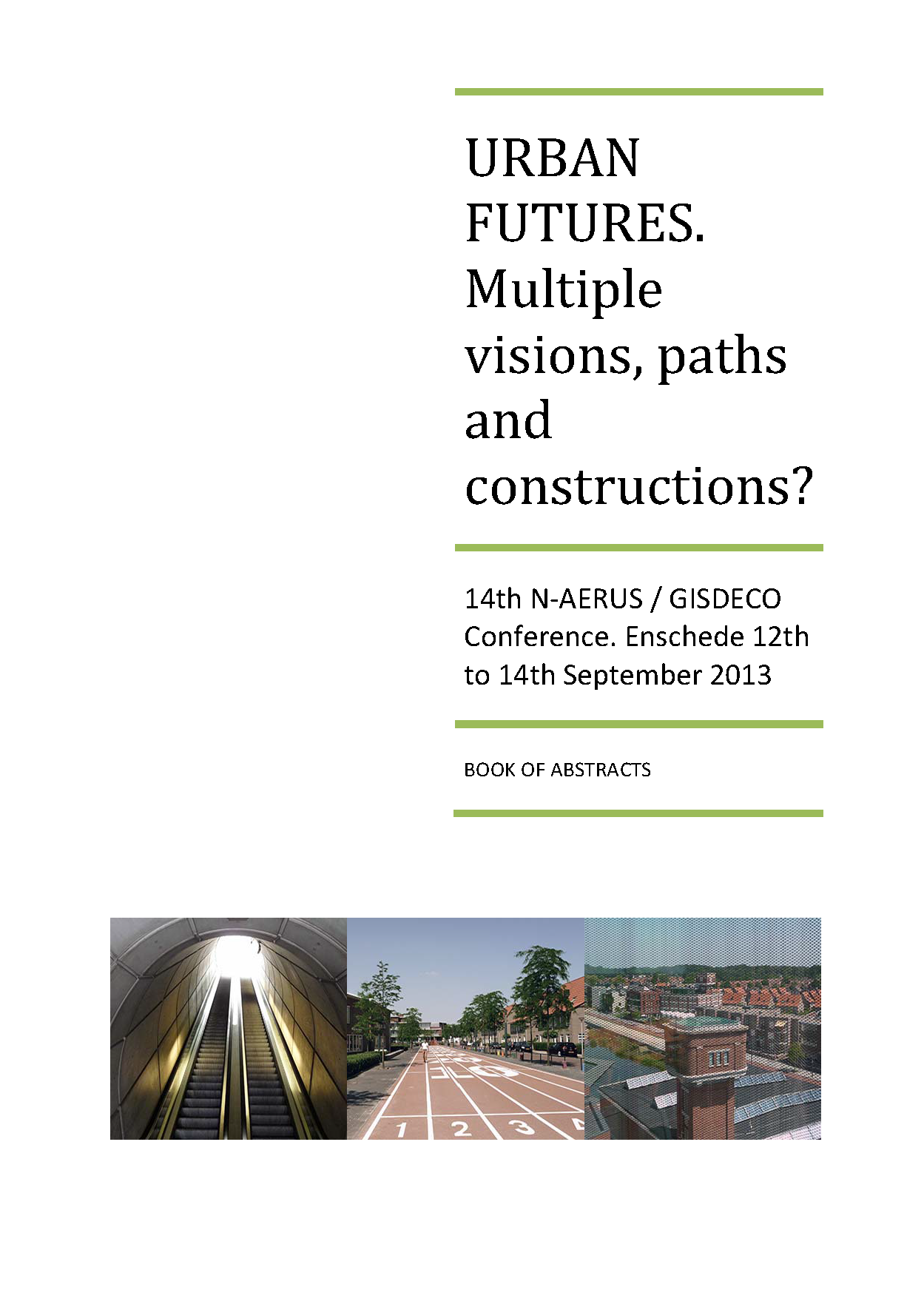 | Sonntagbauer, Peter; Rumm, Nikolaus; Kagitcioglu, Hakan; Nazemi, Kawa; Burkhardt, Dirk GIS, Social Media and Simulation in Integrated ICT Solutions for Urban Futures Proceedings Article In: Proceedings of Network-Association of European Researchers on Urbanisation in the South (N-AERUS): 14th N-AERUS Conference 2013 : Urban Futures. Multiple visions, paths and constructions?, pp. 12, Network-Association of European Researchers on Urbanisation in the South (N-AERUS) Enschede, Netherlands, 2013. Abstract | Links | BibTeX | Tags: e-Participation, FUPOL, GIS, Integrated Approach, Integration Architecture, Urban Policy Lifecycle @inproceedings{Sonntagbauer2018,ICT tools and their methods to support the policy lifecycle in urban planning have drastically changed with the emergence of social media, advanced simulation techniques, open government data, big data, opinion mining, advanced text analytics and visualization. All those components should be combined with GIS.Current ICT solutions supporting e-participation and collaborative urban planning are focused on solving a specific problem. They are not integrated neither on the conceptual nor on the technical level. The conceptual level referring to the policy lifecycle, the technical level to data integration and user interface. This paper describes a new integrated approach to policy design and implementation. It consists of an advanced policy lifecycle and an IT-solution with features supporting all phases of the proposed lifecycle. The concept as well as the technical architecture as implemented in the Future Policy Modelling Project (FUPOL) to achieve such a complete integration with separate applications is outlined. | ||
| 32. | 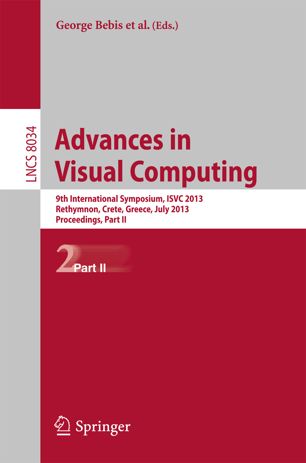 | Burkhardt, Dirk; Nazemi, Kawa; Stab, Christian; Steiger, Martin; Kuijper, Arjan; Kohlhammer, Jörn Visual Statistics Cockpits for Information Gathering in the Policy-Making Process Proceedings Article In: Bebis, George; Boyle, Richard; Parvin, Bahram; Koracin, Darko; Li, Baoxin; Porikli, Fatih; Zordan, Victor; Klosowski, James; Coquillart, Sabine; Luo, Xun; Chen, Min; Gotz, David (Ed.): Advances in Visual Computing. ISVC 2013, pp. 86–97, Springer, Berlin, Heidelberg, Germany, 2013, ISBN: 978-3-642-41939-3. Abstract | Links | BibTeX | Dimensions | PlumX | Tags: Computer Graphic, Information Gathering, Line Chart, Parallel Coordinate, Policy Making Process @inproceedings{Burkhardt2013,A major step in ICT-driven policy making is information gathering. During this phase, analysts and experts have to deal with a high number of statistical data which they use as a basis to identify problems and find appropriate solutions. This paper introduces a statistical data model to support these analysts and experts. It allows for handling the complexity (i.e. the dimensions) of the data for the visualizations. In particular, it helps to use the same data for two-dimensional, but also multi-dimensional statistics visualizations. Based on this statistic data model we introduce an interactive approach of visual statistics cockpits. This results in highly interactive statistics visualization cockpits that enable both analysts and experts to improve problem assessment and solution finding. | ||
| 31. |  | Stab, Christian; Burkhardt, Dirk; Breyer, Matthias; Nazemi, Kawa Visualizing Search Results of Linked Open Data Book Chapter In: Hussein, Tim; Paulheim, Heiko; Lukosch, Stephan; Ziegler, Jürgen; Calvary, Gaëlle (Ed.): Semantic Models for Adaptive Interactive Systems, pp. 133–149, Springer, London, United Kindgdom, 2013, ISBN: 978-1-4471-5301-6. Abstract | Links | BibTeX | Dimensions | PlumX | Tags: Querying, Result List, Search Result, Semantic Information, Task Completion Time @inbook{Stab2013,Finding accurate information of high quality is still a challenging task particularly with regards to the increasing amount of resources in current information systems. This is especially true if policy decisions that impact humans, economy or environment are based on the demanded information. For improving search result generation and analyzing user queries more and more information retrieval systems utilize Linked Open Data and other semantic knowledge bases. Nevertheless, the semantic information that is used during search result generation mostly remains hidden from the users although it significantly supports users in understanding and assessing search results. The presented approach combines information visualizations with semantic information for offering visual feedback about the reasons the results were retrieved. It visually represents the semantic interpretation and the relation between query terms and search results to offer more transparency in search result generation and allows users to unambiguously assess the relevance of the retrieved resources for their individual search. The approach also supports the common search strategies by providing visual feedback for query refinement and enhancement. Besides the detailed description of the search system, an evaluation of the approach shows that the use of semantic information considerably supports users in assessment and decision-making tasks. | ||
2012 |
||||
| 30. | 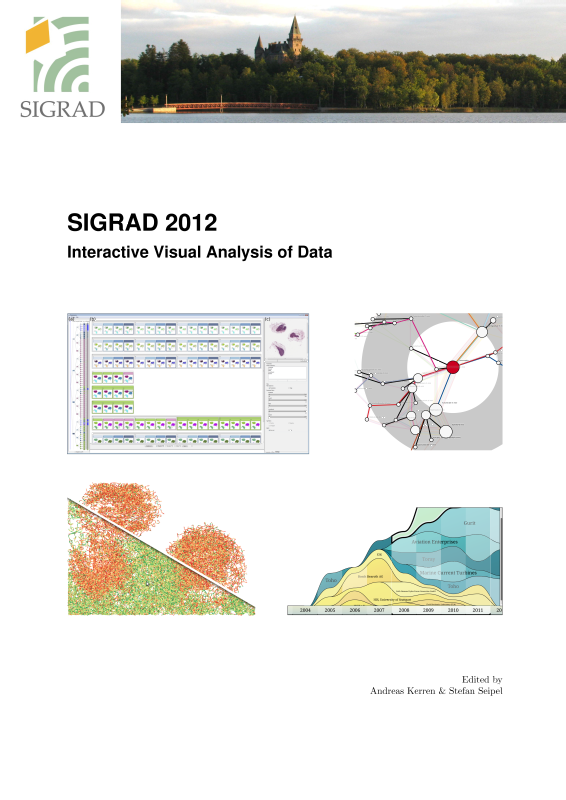 | Stab, Christian; Breyer, Matthias; Burkhardt, Dirk; Nazemi, Kawa; Kohlhammer, Jörn Analytical Semantics Visualization for Discovering Latent Signals in Large Text Collections Proceedings Article In: Kerren, Andreas; Seipel, Stefan (Ed.): Proceedings of SIGRAD 2012: Interactive Visual Analysis of Data, pp. 83-86, EUROGRAPHICS Linköping University Electronic Press, Växjö, Sweden, 2012, ISSN: 1650-3740. Abstract | Links | BibTeX | Tags: Abstracting Methods, Interaction Styles @inproceedings{Stab2012b,Considering the increasing pressure of competition and high dynamics of markets; the early identification and specific handling of novel developments and trends becomes more and more important for competitive companies. Today; those signals are encoded in large amounts of textual data like competitors’ web sites; news articles; scientific publications or blog entries which are freely available in the web. Processing large amounts of textual data is still a tremendous challenge for current business analysts and strategic decision makers. Although current information systems are able to process that amount of data and provide a wide range of information retrieval tools; it is almost impossible to keep track of each thread or opportunity. The presented approach combines semantic search and data mining techniques with interactive visualizations for analyzing and identifying weak signals in large text collections. Beside visual summarization tools; it includes an enhanced trend visualization that supports analysts in identifying latent topic-related relations between competitors and their temporal relevance. It includes a graph-based visualization tool for representing relations identified during semantic analysis. The interaction design allows analysts to verify their retrieved hypothesis by exploring the documents that are responsible for the current view. | ||
| 29. | 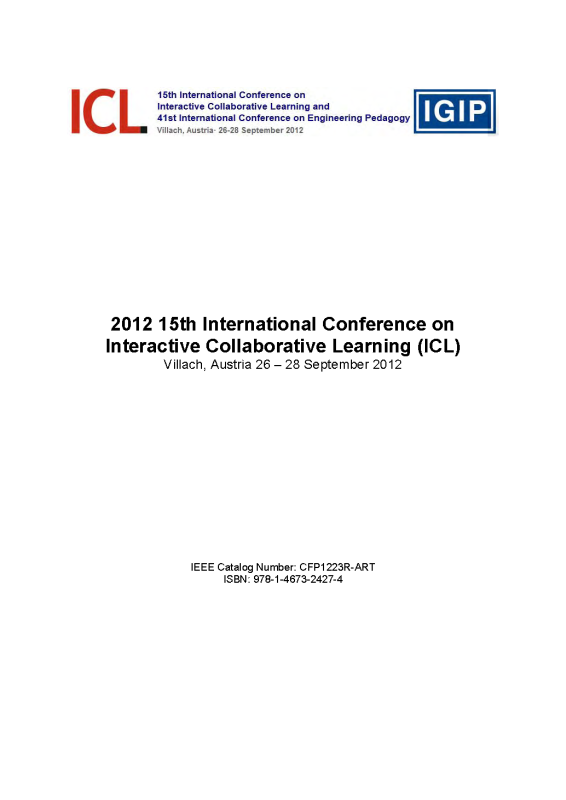 | Burkhardt, Dirk; Ruppert, Tobias; Nazemi, Kawa Dynamic Process Support based on Users’ Behavior Proceedings Article In: Proceedings of 15th International Conference on Interactive Collaborative Learning (ICL 2012), pp. 1-8, IEEE, Piscataway, NJ, USA, 2012, ISBN: 978-1-4673-2427-4. Abstract | Links | BibTeX | Dimensions | PlumX | Tags: Process Management, Process Adaptation, Process Support, User-Centered Interaction @inproceedings{Burkhardt2012d,Nowadays there is a gap between the possibilities and the massively existing data on the one side and the user as main worker on the other side. In different scenarios e.g. search, exploration, analysis and policy-modeling a user has to deal with massive information, but for this work he usually gets a static designed system. So meanwhile data-driven work-processes are increasing in its complexity the support of the users who are working with these data is limited on basic features. Hence this paper describes a concept for a process-supporting approach, which includes relevant aspects of users' behaviors in support him to successfully finish also complex tasks. This will be achieved by a process-based guidance with an automatic tools selection for every process and activity on the one hand. And on the other hand the consideration of expert-level of a user to a single task and process. This expert-level will be classified during each task and process interaction and allow the automatically selection of optimal tools for a concrete task. In final the user gets for every task an automatically initialized user-interface with useful and required tools. | ||
| 28. | 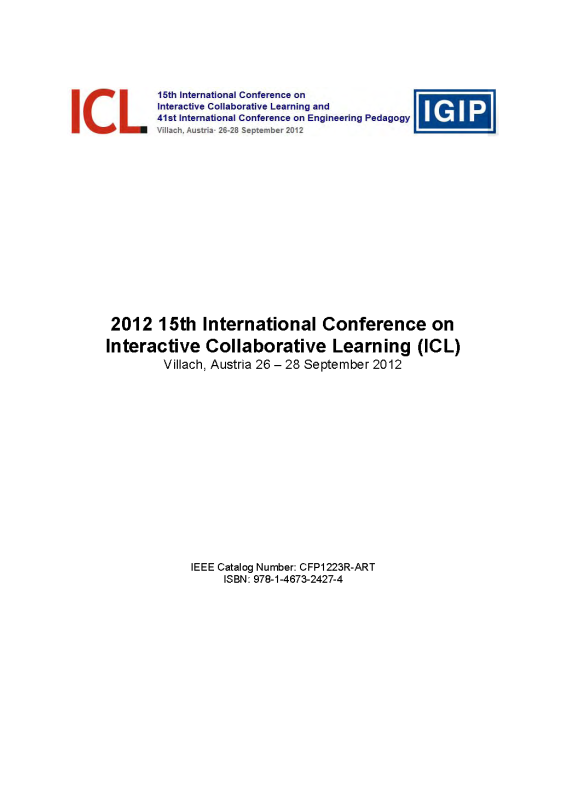 | Burkhardt, Dirk; Ruppert, Tobias; Nazemi, Kawa Towards Process-Oriented Information Visualization For Supporting Users Proceedings Article In: Proceedings of 15th International Conference on Interactive Collaborative Learning (ICL 2012), pp. 1-8, IEEE , Piscataway, NJ, USA, 2012, ISBN: 978-1-4673-2427-4. Abstract | Links | BibTeX | Dimensions | PlumX | Tags: Information Visualization, Process Management, Process Adaptation, Process Support, Process-oriented Information Visualization, User-Centered Interaction @inproceedings{Burkhardt2012b,Nowadays daily office work consists of dealing with big numbers of data and data sources, and furthermore of working with complex computer programs. In consequence many users have problems to use such programs effective and efficient. In particular beginners have significant problems to use the programs correctly due to complex functionality and interaction options. To avoid this overload of the user, the Information Visualization community has recently developed some approaches that aim to support the users. Unfortunately, these approaches are limited to one special aspect, and sometimes they are just appropriate for one special task. Thus, in this paper we introduce a process-oriented user-supporting approach. It allows selecting adequate supporting techniques in correlation to a performed process and activity to guide the user and help him to solve his task. Furthermore, we show the benefits of designing programs and applications, which implement process definitions for the existing tasks to provide the user with better process orientation. This guides the user through difficult and complex processes. | ||
| 27. | 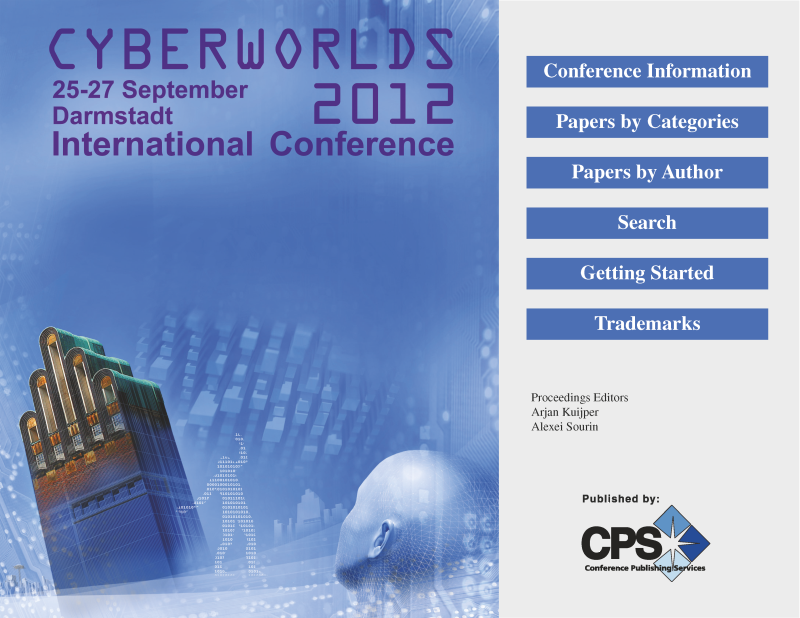 | Burkhardt, Dirk; Stab, Christian; Steiger, Martin; Breyer, Matthias; Nazemi, Kawa Interactive Exploration System: A User-Centered Interaction Approach in Semantics Visualizations Proceedings Article In: Kuijper, Arjan; Sourin, Alexei (Ed.): Proceedings of the 2012 International Conference on Cyberworlds (Cyberworlds 2012), pp. 261–267, IEEE, Piscataway, NJ, USA, 2012, ISBN: 978-0-7695-4814-2. Abstract | Links | BibTeX | Dimensions | PlumX | Tags: Multimodal Interaction, Semantic Web, Semantics Visualization, User-Centered Systems @inproceedings{Burkhardt2012,Nowadays a wide range of input devices are available to users of technical systems. Especially modern alternative interaction devices, which are known from game consoles etc., provide a more natural way of interaction. In parallel to that the research on visualization of large amount of data advances very quickly. This research was also influenced by the semantic web and the idea of storing data in a structured and linked form. The semantically annotated data gains more and more importance in information acquisition processes. Especially the Linked Open Data (LOD) format already experienced a huge growth. However, the user-interfaces of web-applications mostly do not reflect the added value of semantics data. This paper describes the conceptual design and implementation of an Interactive Exploration System that offers a user-centered graphical environment of web-based knowledge repositories, to support and optimize explorative learning, and the integration of a taxonomy-based approach to enable the use of more natural interaction metaphors, as they are possible with modern devices like Wii Mote or Microsoft Kinect. Therefore we introduce a different classification for interaction devices, and current approaches for supporting the added values in semantics visualizations. Furthermore, we describe the concept of our IES, including a strategy to organize and structure today's existing input devices, and a semantics exploration system driven by user-experience. We conclude the paper with a description of the implementation of the IES and an application scenario. | ||
| 26. | 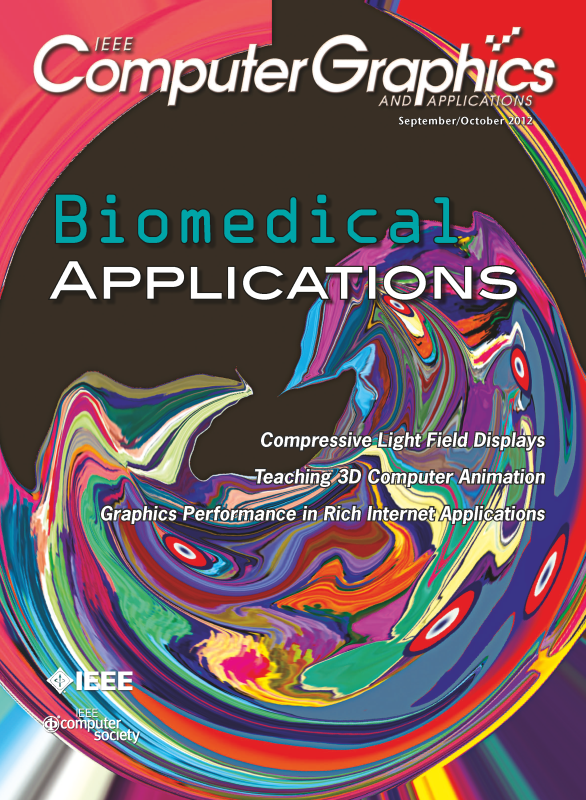 | Kohlhammer, Jörn; Nazemi, Kawa; Ruppert, Tobias; Burkhardt, Dirk Toward Visualization in Policy Modeling Journal Article In: IEEE Computer Graphics and Applications, vol. 32, no. 5, pp. 84–89, 2012, ISSN: 0272-1716. Abstract | Links | BibTeX | Dimensions | PlumX | Tags: Analytical Models, Computational Modeling, Data Visualization, Decision Making, Semantics, Visualization @article{Burkhardt2012d,This article looks at the current and future roles of information visualization, semantics visualization, and visual analytics in policy modeling. Many experts believe that you can't overestimate visualization's role in this respect. | ||
| 25. |  | Breyer, Matthias; Birkenbusch, Jana; Burkhardt, Dirk; Schwarz, Christopher; Stab, Christian; Nazemi, Kawa; Christ, Oliver Visualizations Encourage Uncertain Users to High Effectiveness Proceedings Article In: Salvendy, Gavriel; Karwowski, Waldemar (Ed.): Advances in Human Factors and Ergonomics 2012- 14 Volume Set: Proceedings of the 4th AHFE Conference 21-25 July 2012, pp. 8066–8074, Taylor & Francis CRC Press, Boca Raton, FL, USA, 2012, ISBN: 9781466552623. Abstract | Links | BibTeX | Tags: effectiveness, Evaluation, Satisfaction, Visualization @inproceedings{Breyer2012,Users have to handle a lot of information in order to fulfill their current task. For achieving an appropriate time and level of quality the users’ motivation plays a key role. In this paper we present a user study which aimed to evaluate if the self-rated expertise of the subjects in their computer system skills has an impact on their task completion effectiveness using visualizations. The results reveal that regardless of the self-rated assurance of the users, no significant difference in the effectiveness of task completions using visualizations could be registered. Furthermore the participants indicate in the questionnaire that using visualization their individual satisfaction level had no significant differences when compared to the users’ self-assurance levels. This indicates even users feeling not confident in interacting with computer systems they may feel confident in interacting with visualizations. Thus if visualizations are applied for tasks of information search and exploration, the user is encouraged to higher effectiveness. | ||
| 24. |  | Breyer, Matthias; Birkenbusch, Jana; Burkhardt, Dirk; Schwarz, Christopher; Stab, Christian; Nazemi, Kawa; Christ, Oliver Visualizations Encourage Uncertain Users to High Effectiveness Book Chapter In: Ji, Yong Gu (Ed.): Advances in Affective and Pleasurable Design, Chapter 80, pp. 742–750, CRC Press, Boca Raton, FL, USA, 1, 2012, ISBN: 9781439871188. Abstract | Links | BibTeX | Tags: effectiveness, Evaluation, Satisfaction, Visualization @inbook{Breyer2012b,Users have to handle a lot of information in order to fulfill their current task. For achieving an appropriate time and level of quality the users’ motivation plays a key role. In this paper we present a user study which aimed to evaluate if the self-rated expertise of the subjects in their computer system skills has an impact on their task completion effectiveness using visualizations. The results reveal that regardless of the self-rated assurance of the users, no significant difference in the effectiveness of task completions using visualizations could be registered. Furthermore the participants indicate in the questionnaire that using visualization their individual satisfaction level had no significant differences when compared to the users’ self-assurance levels. This indicates even users feeling not confident in interacting with computer systems they may feel confident in interacting with visualizations. Thus if visualizations are applied for tasks of information search and exploration, the user is encouraged to higher effectiveness. | ||
| 23. |  | Stab, Christian; Nazemi, Kawa; Breyer, Matthias; Burkhardt, Dirk; Kohlhammer, Jörn Semantics Visualization for Fostering Search Result Comprehension Proceedings Article In: Simperl, Elena; Cimiano, Philipp; Polleres, Axel; Corcho, Oscar; Presutti, Valentina (Ed.): The Semantic Web: Research and Applications; Research and Applications. ESWC 2012, pp. 633–646, Springer, Berlin, Heidelberg, Germany, 2012, ISBN: 978-3-642-30284-8. Abstract | Links | BibTeX | Dimensions | PlumX | Tags: Information Visualization, Search User Interface, Semantic Search, SemaVis, Visual Query Enhancement @inproceedings{Stab2012,Current search engines present search results in an ordered list even if semantic technologies are used for analyzing user queries and the document contents. The semantic information that is used during the search result generation mostly remains hidden from the user although it significantly supports users in understanding why search results are considered as relevant for their individual query. The approach presented in this paper utilizes visualization techniques for offering visual feedback about the reasons the results were retrieved. It represents the semantic neighborhood of search results, the relations between results and query terms as well as the relevance of search results and the semantic interpretation of query terms for fostering search result comprehension. It also provides visual feedback for query enhancement. Therefore, not only the search results are visualized but also further information that occurs during the search processing is used to improve the visual presentation and to offer more transparency in search result generation. The results of an evaluation in a real application scenario show that the presented approach considerably supports users in assessment and decision-making tasks and alleviates information seeking in digital semantic knowledge bases. | ||
2011 |
||||
| 22. |  | Burkhardt, Dirk; Breyer, Matthias; Stab, Christian; Nazemi, Kawa Facilitate Access to E-Knowledge for Adult People in Rural Areas Proceedings Article In: Proceedings of International Conference of Education, Research and Innovation (ICERI2011), pp. 2050–2057, IATED, Valencia, Spain, 2011, ISSN: 2340-1095. Abstract | Links | BibTeX | Dimensions | PlumX | Tags: e-Knowledge, e-Learning, Learning in Rural Areas, Learning Strategy, Platform, Portal, Provider, Virtual Learning @inproceedings{Burkhardt2011f,Today’s society especially in the western world is marked by life-long learning, because of an increasing technology development primary in Information Communication Technologies and because of an increasing need of up-to-date experts. In contrast to urban regions, the education in rural areas often is only possible virtually. Therefore, a various number of e-Learning Systems exist, that are oftentimes hard to use especially for less computer experienced users. For providing a facilitated access to e-Knowledge in such e-Learning Systems this paper describes an approach for developing an easy usable and understandable portal that furthermore aims to achieve a positive emotional feeling. These emotional aspects, subsumed in user experience, are a necessary factor if the user should be motivated and supported during his learning process. | ||
| 21. |  | Burkhardt, Dirk; Frossard, Frédérique; Barajas, Mario; Obermüller, Marion; Monika, Moises; Nazemi, Kawa RURALeNTER: Capacity Building through ICT in Rural Areas Proceedings Article In: Proceedings of International Conference of Education, Research and Innovation (ICERI2011), pp. 1348–1354, IATED, Valencia, Spain, 2011, ISSN: 2340-1095. Abstract | Links | BibTeX | Dimensions | PlumX | Tags: e-Learning, Learning in Rural Areas, Learning of Adult Populations, Learning Strategy @inproceedings{Burkhardt2011g,The requirements on today’s employees have been changed in the past. Today the western world needs significant more well educated employees, often named as experts. To be attractive for the job market the employees have to stay up-to-date and to improve their skills continuously, so lifelong-learning becomes important for the business carrier. But especially this advanced learning becomes difficult for people in rural regions. The existing strategies like improving kills on adult education centres is not appropriated for the rural population because of e.g. traveling costs.To solve this discriminating circumstance is the main goal of the RURALeNTER project. The project aims to develop a new approach how advanced education can be provided to the rural population by using modern technologies over internet. The effective use of specifically to the requirements of rural population developed internet tools enables even for beginners the possibility to be similar effective as the advanced training that is provided in urban regions in the traditional form. The resulting approach was tested and used amongst others in Spain, Austria and Romania. | ||
| 20. |  | Burkhardt, Dirk; Frossard, Frédérique; Barajas, Mario; Obermüller, Marion RURALeNTER: Capacity Building through ICT in Rural Areas Proceedings Article In: Proceedings of Workshop of the EDEN Open Classroom 2011 Conference: Lifelong Learning in RURAL and Remote Areas, pp. 29–38, Pallini, Athens, Greece, 2011, ISBN: 978-960-473-323-1. Abstract | Links | BibTeX | Dimensions | PlumX | Tags: e-Learning, Learning in Rural Areas, Learning of Adult Populations, Learning Strategy @inproceedings{Burkhardt2011f,The requirements on today’s employees have been changed in the past. Today the western world needs significant more well educated employees, often named as experts. To be attractive for the job market the employees have to stay up-to-date and to improve their skills continuously, so lifelong-learning becomes important for the business carrier. But especially this advanced learning becomes difficult for people in rural regions. The existing strategies like improving skills on adult education centres is not appropriated for the rural population because of e.g. traveling costs. To solve this discriminating circumstance is the main goal of the RURALeNTER project. The project aims to develop a new approach how advanced education can be provided to the rural population by using modern technologies over internet. The effective use of specifically to the requirements of rural population developed internet tools enables even for beginners the possibility to be similar effective as the advanced training that is provided in urban regions in the traditional form. The resulting approach was tested and used amongst others in Spain, Austria and Romania. | ||
| 19. |  | Nazemi, Kawa; Breyer, Matthias; Stab, Christian; Burkhardt, Dirk; Fellner, Dieter W. Intelligent Exploration System - An Approach for User-Centered Exploratory Learning Proceedings Article In: Proceedings of Workshop of the EDEN Open Classroom 2011 Conference: Lifelong Learning in RURAL and Remote Areas, pp. 71–83, Pallini, Athens, Greece, 2011, ISBN: 978-960-473-323-1. Abstract | Links | BibTeX | Dimensions | PlumX | Tags: Information Visualization, Intelligent Tutoring Systems, Knowledge Discovery, Knowledge Exploration @inproceedings{Nazemi2018,The following paper describes the conceptual design of an Intelligent Exploration System (IES) that offers a user-adapted graphical environment of web-based knowledge repositories, to support and optimize the explorative learning. The paper starts with a short definition of learning by exploring and introduces the Intelligent Tutoring System and Semantic Technologies for developing such an Intelligent Exploration System. The IES itself will be described with a short overview of existing learner or user analysis methods, visualization techniques for exploring knowledge with semantics technology and the explanation of the characteristics of adaptation to offer a more efficient learning environment. | ||
| 18. | 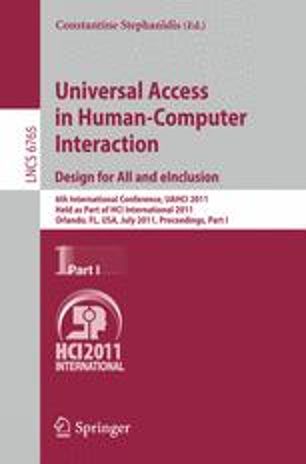 | Burkhardt, Dirk; Breyer, Matthias; Glaser, Christian; Nazemi, Kawa; Kuijper, Arjan Classifying Interaction Methods to Support Intuitive Interaction Devices for Creating User-Centered-Systems Proceedings Article In: Stephanidis, Constantine (Ed.): Universal Access in Human-Computer Interaction. Design for All and eInclusion, pp. 20–29, Springer, Berlin, Heidelberg, Germany, 2011, ISBN: 978-3-642-21672-5. Abstract | Links | BibTeX | Dimensions | PlumX | Tags: Gesture-based Interaction, Human-Centered Interfaces, Human-Computer-Interfaces, Multimodal Interaction @inproceedings{Burkhardt2011c,Nowadays a wide range of input devices are available to users of technical systems. Especially modern alternative interaction devices, which are known from game consoles etc., provide a more natural way of interaction. But the support in computer programs is currently a big challenge, because a high effort is to invest for developing an application that supports such alternative input devices. For this fact we made a concept for an interaction system, which supports the use of alternative interaction devices. The interaction-system consists as central element a server, which provides a simple access interface for application to support such devices. It is also possible to address an abstract device by its properties and the interaction-system overtakes the converting from a concrete device. For realizing this idea, we also defined a taxonomy for classifying interaction devices by its interaction method and in dependence to the required interaction results, like recognized gestures. Later, by using this system, it is generally possible to develop a user-centered system by integrating this interaction-system, because an adequate integration of alternative interaction devices provides a more natural and easy to understand form of interaction. | ||
| 17. |  | Burkhardt, Dirk; Breyer, Matthias; Nazemi, Kawa; Kuijper, Arjan Search Intention Analysis for User-Centered Adaptive Visualizations Proceedings Article In: Stephanidis, Constantine (Ed.): Universal Access in Human-Computer Interaction. Design for All and eInclusion, pp. 317–326, Springer, Berlin, Heidelberg, Germany, 2011, ISBN: 978-3-642-21672-5. Abstract | Links | BibTeX | Dimensions | PlumX | Tags: Adaptive Visualization, Search Result Visualization, Semantic Visualization, Semantic Web, User Intention Analysis, User-Centered Interaction @inproceedings{10.1007/978-3-642-21672-5_35,Searching information on web turned to a matter of course in the last years. The visualization and filtering of the results of such search queries plays a key-role in different disciplines and is still today under research. In this paper a new approach for classifying the search intention of users’ is presented. The approach uses existing and easy parameters for a differentiation between explorative and targeted search. The results of the classification are used for a differentiated presentation based on graphical visualization techniques. | ||
2014 |
||||
| 41. |  | Visual Process Support to Assist Users in Policy Making Book Chapter In: Sonntagbauer, Peter; Nazemi, Kawa; Sonntagbauer, Susanne; Prister, Giorgio; Burkhardt, Dirk (Ed.): Handbook of Research on Advanced ICT Integration for Governance and Policy Modeling, Chapter 9, pp. 129–148, IGI Global, Hershey, PA, USA, 2014, ISBN: 9781466662360. | ||
| 40. |  | Information Visualization and Policy Modeling Book Chapter In: Sonntagbauer, Peter; Nazemi, Kawa; Sonntagbauer, Susanne; Prister, Giorgio; Burkhardt, Dirk (Ed.): Handbook of Research on Advanced ICT Integration for Governance and Policy Modeling, Chapter 11, pp. 175–215, IGI Global, Hershey, PA, USA, 2014, ISBN: 9781466662360. | ||
| 39. |  | The FUPOL Policy Lifecycle Book Chapter In: Sonntagbauer, Peter; Nazemi, Kawa; Sonntagbauer, Susanne; Prister, Giorgio; Burkhardt, Dirk (Ed.): Handbook of Research on Advanced ICT Integration for Governance and Policy Modeling, Chapter 5, pp. 61–87, IGI Global, Hershey, PA, USA, 2014, ISBN: 9781466662360. | ||
| 38. |  | Policy Modeling Methodologies Book Chapter In: Sonntagbauer, Peter; Nazemi, Kawa; Sonntagbauer, Susanne; Prister, Giorgio; Burkhardt, Dirk (Ed.): Handbook of Research on Advanced ICT Integration for Governance and Policy Modeling, Chapter 4, pp. 48–60, IGI Global, Hershey, PA, USA, 2014, ISBN: 9781466662360. | ||
| 37. |  | Fundamental Aspects for E-Government Book Chapter In: Sonntagbauer, Peter; Nazemi, Kawa; Sonntagbauer, Susanne; Prister, Giorgio; Burkhardt, Dirk (Ed.): Handbook of Research on Advanced ICT Integration for Governance and Policy Modeling, Chapter 1, pp. 1–18, IGI Global, Hershey, PA, USA, 2014, ISBN: 9781466662360. | ||
| 36. |  | Handbook of Research on Advanced ICT Integration for Governance and Policy Modeling Book IGI Global, Hershey, PA, USA, 2014, ISBN: 9781466662360. | ||
| 35. |  | Visualization Adaptation Based on Environmental Influencing Factors Proceedings Article In: Kurosu, Masaaki (Ed.): Human-Computer Interaction. Theories, Methods, and Tools. HCI 2014, pp. 411–422, Springer International Publishing, Switzerland, 2014, ISBN: 978-3-319-07233-3. | ||
2013 |
||||
| 34. |  | Interactive Visualizations in the Process of Policy Modelling Proceedings Article In: Wimmer, Maria A.; Janssen, Marijn; Macintosh, Ann; Scholl, Hans Jochen; Tambouris, Efthimios (Ed.): Electronic Government and Electronic Participation - Joint Proceedings of Ongoing Research of IFIP EGOV and IFIP ePart 2013, pp. 104–115, Gesellschaft für Informatik e.V. Köllen Druck+Verlag GmbH, Bonn, Germany, 2013, ISSN: 1617-5468, (ISBN: 978-3-88579-615-2). | ||
| 33. |  | GIS, Social Media and Simulation in Integrated ICT Solutions for Urban Futures Proceedings Article In: Proceedings of Network-Association of European Researchers on Urbanisation in the South (N-AERUS): 14th N-AERUS Conference 2013 : Urban Futures. Multiple visions, paths and constructions?, pp. 12, Network-Association of European Researchers on Urbanisation in the South (N-AERUS) Enschede, Netherlands, 2013. | ||
| 32. |  | Visual Statistics Cockpits for Information Gathering in the Policy-Making Process Proceedings Article In: Bebis, George; Boyle, Richard; Parvin, Bahram; Koracin, Darko; Li, Baoxin; Porikli, Fatih; Zordan, Victor; Klosowski, James; Coquillart, Sabine; Luo, Xun; Chen, Min; Gotz, David (Ed.): Advances in Visual Computing. ISVC 2013, pp. 86–97, Springer, Berlin, Heidelberg, Germany, 2013, ISBN: 978-3-642-41939-3. | ||
| 31. |  | Visualizing Search Results of Linked Open Data Book Chapter In: Hussein, Tim; Paulheim, Heiko; Lukosch, Stephan; Ziegler, Jürgen; Calvary, Gaëlle (Ed.): Semantic Models for Adaptive Interactive Systems, pp. 133–149, Springer, London, United Kindgdom, 2013, ISBN: 978-1-4471-5301-6. | ||
2012 |
||||
| 30. |  | Analytical Semantics Visualization for Discovering Latent Signals in Large Text Collections Proceedings Article In: Kerren, Andreas; Seipel, Stefan (Ed.): Proceedings of SIGRAD 2012: Interactive Visual Analysis of Data, pp. 83-86, EUROGRAPHICS Linköping University Electronic Press, Växjö, Sweden, 2012, ISSN: 1650-3740. | ||
| 29. |  | Dynamic Process Support based on Users’ Behavior Proceedings Article In: Proceedings of 15th International Conference on Interactive Collaborative Learning (ICL 2012), pp. 1-8, IEEE, Piscataway, NJ, USA, 2012, ISBN: 978-1-4673-2427-4. | ||
| 28. |  | Towards Process-Oriented Information Visualization For Supporting Users Proceedings Article In: Proceedings of 15th International Conference on Interactive Collaborative Learning (ICL 2012), pp. 1-8, IEEE , Piscataway, NJ, USA, 2012, ISBN: 978-1-4673-2427-4. | ||
| 27. |  | Interactive Exploration System: A User-Centered Interaction Approach in Semantics Visualizations Proceedings Article In: Kuijper, Arjan; Sourin, Alexei (Ed.): Proceedings of the 2012 International Conference on Cyberworlds (Cyberworlds 2012), pp. 261–267, IEEE, Piscataway, NJ, USA, 2012, ISBN: 978-0-7695-4814-2. | ||
| 26. |  | Toward Visualization in Policy Modeling Journal Article In: IEEE Computer Graphics and Applications, vol. 32, no. 5, pp. 84–89, 2012, ISSN: 0272-1716. | ||
| 25. |  | Visualizations Encourage Uncertain Users to High Effectiveness Proceedings Article In: Salvendy, Gavriel; Karwowski, Waldemar (Ed.): Advances in Human Factors and Ergonomics 2012- 14 Volume Set: Proceedings of the 4th AHFE Conference 21-25 July 2012, pp. 8066–8074, Taylor & Francis CRC Press, Boca Raton, FL, USA, 2012, ISBN: 9781466552623. | ||
| 24. |  | Visualizations Encourage Uncertain Users to High Effectiveness Book Chapter In: Ji, Yong Gu (Ed.): Advances in Affective and Pleasurable Design, Chapter 80, pp. 742–750, CRC Press, Boca Raton, FL, USA, 1, 2012, ISBN: 9781439871188. | ||
| 23. |  | Semantics Visualization for Fostering Search Result Comprehension Proceedings Article In: Simperl, Elena; Cimiano, Philipp; Polleres, Axel; Corcho, Oscar; Presutti, Valentina (Ed.): The Semantic Web: Research and Applications; Research and Applications. ESWC 2012, pp. 633–646, Springer, Berlin, Heidelberg, Germany, 2012, ISBN: 978-3-642-30284-8. | ||
2011 |
||||
| 22. |  | Facilitate Access to E-Knowledge for Adult People in Rural Areas Proceedings Article In: Proceedings of International Conference of Education, Research and Innovation (ICERI2011), pp. 2050–2057, IATED, Valencia, Spain, 2011, ISSN: 2340-1095. | ||
| 21. |  | RURALeNTER: Capacity Building through ICT in Rural Areas Proceedings Article In: Proceedings of International Conference of Education, Research and Innovation (ICERI2011), pp. 1348–1354, IATED, Valencia, Spain, 2011, ISSN: 2340-1095. | ||
| 20. |  | RURALeNTER: Capacity Building through ICT in Rural Areas Proceedings Article In: Proceedings of Workshop of the EDEN Open Classroom 2011 Conference: Lifelong Learning in RURAL and Remote Areas, pp. 29–38, Pallini, Athens, Greece, 2011, ISBN: 978-960-473-323-1. | ||
| 19. |  | Intelligent Exploration System - An Approach for User-Centered Exploratory Learning Proceedings Article In: Proceedings of Workshop of the EDEN Open Classroom 2011 Conference: Lifelong Learning in RURAL and Remote Areas, pp. 71–83, Pallini, Athens, Greece, 2011, ISBN: 978-960-473-323-1. | ||
| 18. |  | Classifying Interaction Methods to Support Intuitive Interaction Devices for Creating User-Centered-Systems Proceedings Article In: Stephanidis, Constantine (Ed.): Universal Access in Human-Computer Interaction. Design for All and eInclusion, pp. 20–29, Springer, Berlin, Heidelberg, Germany, 2011, ISBN: 978-3-642-21672-5. | ||
| 17. |  | Search Intention Analysis for User-Centered Adaptive Visualizations Proceedings Article In: Stephanidis, Constantine (Ed.): Universal Access in Human-Computer Interaction. Design for All and eInclusion, pp. 317–326, Springer, Berlin, Heidelberg, Germany, 2011, ISBN: 978-3-642-21672-5. | ||
